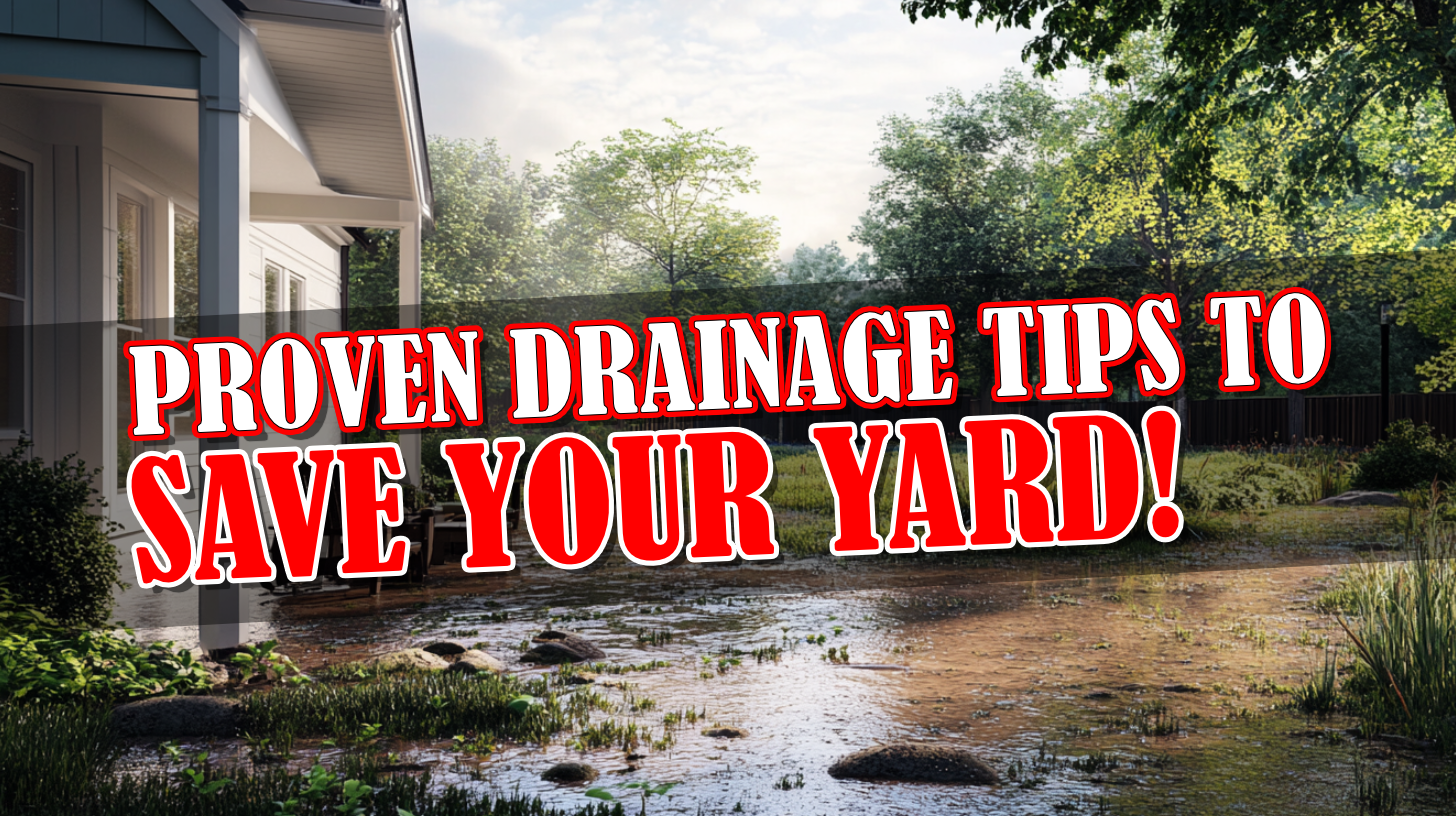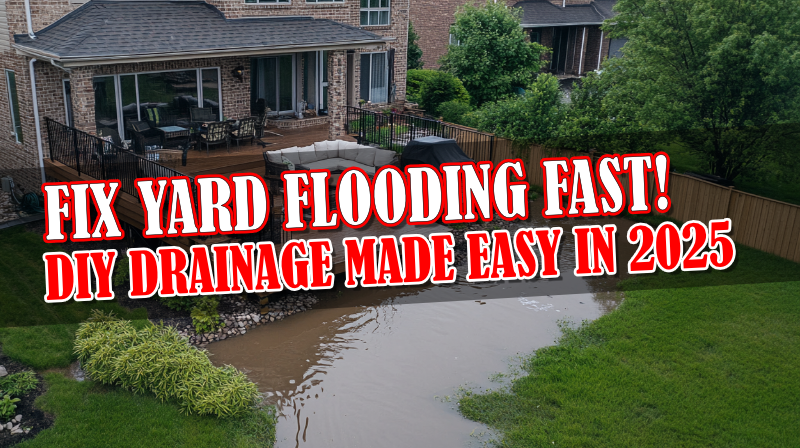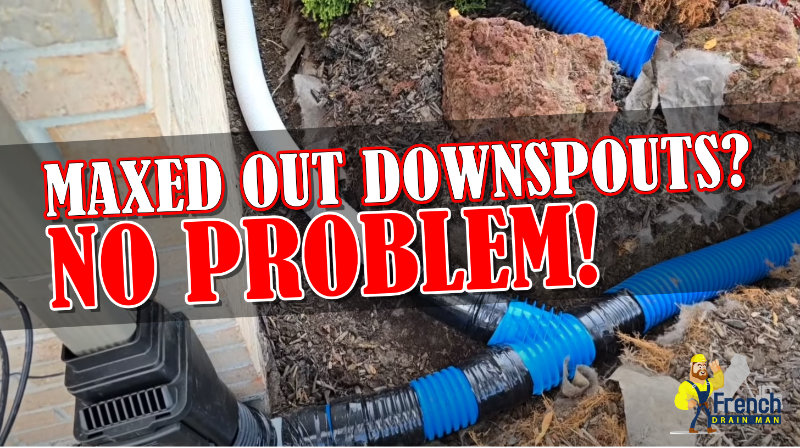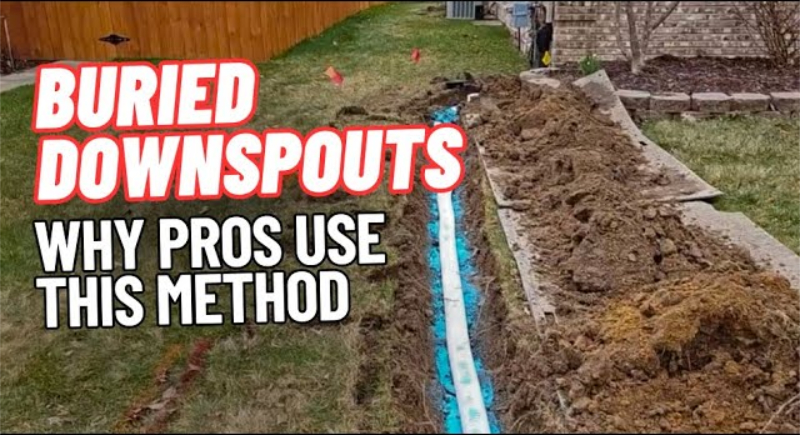
French Drain Mistakes: Introduction
Robert Sherwood here, your friendly neighborhood French Drain Man. If you’re reading this, your lawn or basement may have become soggy or even unpleasant when it rains. Worry no more; today, I will impart some invaluable knowledge regarding French drains!
French drains have long been used to keep basements dry and yards beautiful, yet they’re far from foolproof. I have witnessed my fair share of DIY drainage disasters over time, so I want to address the top ten errors homeowners typically make with French drains.
Trust me; I’ve seen it all: drains installed improperly, trenches that look more like puddles, pipes clogged with tree roots or children’s toys, and so much more. Please don’t be alarmed, though: my job is not to scare you but to arm you with the knowledge to avoid these potential pitfalls and ensure your French drain does its job and keeps both home and yard high and dry.
French Drain Mistake 1: Incorrect Placement
Let’s address one of the more frequent blunders I see: installing your French drain in an inappropriate location. People seem to believe a French drain should hug their house like an anxious puppy – but that can only end in disaster!
Location Is Everything
A French drain should act like a moat around your castle (aka your home). Its purpose should be to stop water before it breaches your walls. Unfortunately, installing one too close to the foundation could already cause irreparable damage as it seeps into the soil beneath your foundation, exerting pressure against your walls and leading to leaks or cracks that cause leakage issues.
Finding the Sweet Spot
So, where should a French drain go? As a general guideline, this golden rule should apply when placing one uphill from where it’s needed. For instance, if your basement’s flooding, install it uphill from its foundation, while for yards becoming swamps, place it where water begins collecting. Intercepting that flood of liquid before it creates havoc is key here!
Avoid Common Placement Mistakes to Gain Success
- Too Close to the Foundation: Being too close can worsen basement seepage by increasing water pressure and increasing basement seepage.
- Water Needs an Outlet: When water has no outlet, it needs somewhere to go! Ensure your drain slopes towards a suitable discharge point such as a ditch, storm drain, or dry well for properly discharging its contents.
- Your Drain Should Run Parallel with Slopes: Your drain should run parallel to a slope instead of across to capture any runoff that travels downhill. This allows it to capture more of its load.
- Where there is Heavy Foot Traffic: Compacted soil makes water drainage harder, so installing French drains beneath driveways or walkways could impede its path to drain off more efficiently.
Get It Right From the Beginning
Placement of a French drain is vital to its effectiveness; otherwise, you risk water damage to both your home and yard. Before starting to dig, carefully examine your property. Please note where water collects after rainfall and determine the most efficient path for its drainage away. If in doubt, seeking professional advice might also be beneficial as they can assess drainage issues and recommend optimal placement for your French drain – keeping everyone happy and dry!
French Drain Mistake 2: Inadequate Slope
Let’s discuss the importance of having an ideal slope. No, I don’t mean hitting ski slopes here. Ensuring your French drain trench has an optimal gradient is equally essential for smooth sailing for water to flow along its course.
Why Slope Matters
Imagine trying to roll a ball downhill. What will happen if the hill is too flat if your ball sits there? Well, the same applies for your French drain: water needs some assistance to move through, otherwise it will remain stagnant puddles inside of it, doing no one any good at all. Without an appropriate slope, this water could sit unused until its time comes for drainage again.
On the flip side, a slope should not be too steep either. Imagine this: Too steep, and water may rush off at full force without time for absorption into the soil. We should aim for an equilibrium between steepness and a gentle slope that allows water to move at its own natural pace while giving enough time for absorption into ground layers.
The Magic Number: 1%
So, what should the ideal slope of a French drain be? Ideally, aim for around 1%; that means your drain should drop about one inch for every eight feet in length. Of course, this may differ depending on your soil type and water volumes – heavy clay soil may need a steeper gradient for adequate drainage.
How to Check Your Slope
There is no need for complex math calculations when it comes to checking your slope; all it takes is some essential tools and knowledge of soil shifting over time—such as line levels and measuring tapes—to check it regularly and adjust it if necessary, along with rainstorms or water pooling in drains.
French Drain Mistake 3: Using the Wrong Size Gravel
Size plays an integral part when selecting French drain gravel, and choosing an improper type can invite clogs and blockages into your drain system.
Goldilocks Zone
Your ideal gravel will fit snugly between being too small and too large – like Goldilocks finding her porridge! Pea gravel would be too small, likely clogging drains rapidly; large landscaping rocks might prevent water from flowing through freely enough.
The ideal gravel size should range between 3/4 and 1 inch in diameter for optimal water drainage while offering enough room to percolate into the soil. This size provides good water drainage and space for percolation into the ground.
Clean and Round Gravel
Aside from choosing clean gravel that has been washed clean of debris that could block your drain, another vital consideration is ensuring it has more space between stones than crushed stones so water can pass more freely between them. Rounder edges create more open areas between stones, which allows more water to pass through easily.
Do Not Skimp on Quality
Even though gravel might not seem like the most exciting purchase, don’t be tempted to opt for the least expensive option. Cheap gravel might contain impurities or break down quickly, resulting in clogs and headaches in the future—investing a few extra dollars now could save you from future headaches!
French Drain Mistake 4: Not Using Filter Fabric
Let’s talk geotextile double-punched filter fabric: While not the most glamorous part of a French drain system; this material is essential to keeping drains clog-free and open for drainage. Unfortunately, many homeowners skip this step out of expense concerns, but trust me—fabric like this is worth its weight in gold in keeping your drain clear of obstructions!
Geotextile double-punched filter fabric acts like a coffee filter, allowing water to pass through while keeping grounds out. In a French drain, this fabric acts as a barrier between soil and gravel while simultaneously preventing dirt, sand, or other debris from clogging the works of drainage systems.
What Will Happen Without Fabric?
Without this protective fabric layer, your beautiful gravel bed could quickly become an unsightly mess! Soil particles seep into the spaces between stones, blocking water flow. This leads to backups and overflows, which result in useless drain clogs; no one wants to spend their weekend digging up drains!
Why double-punched geotextile fabric?
Filter fabrics do not all serve equal purposes. Geotextile double-punched fabric has been created explicitly for drainage applications. It allows water to pass easily while remaining firm enough to withstand tears or punctures from tears in its fabric threads—ensuring it withstands both the weight of gravel and the pressure of flowing water without punctures or tears affecting performance.
- Common Filter Fabric Mistakes: What To Watch Out for
- Do Not Purchase Landscape Fabric or Weed Barrier: When purchasing drainage fabric or weed barrier for landscaping applications, remember that they were not designed for drainage and may quickly clog.
- Lack of Coverage: Fabric should overlap generously where it meets pipes to avoid gaps where soil can seep in and create potential risks of infiltration.
- Failure to Use Quality Fabric: Fabric that tears easily is not an investment; invest in high-grade geotextile double-punched fabric for maximum performance.
Protect Your Investment with Proper Planning
Installing geotextile double-punched filter fabric correctly is one of the best ways to protect your French drain investment and save both headaches (and money!) in the long run. Don’t install this crucial element; your drain (and wallet!) will thank you!
French Drain Mistake 5: Poor Pipe Selection
Attention all French drain enthusiasts! Now is the time to highlight one of its unsung heroes – the pipe itself. Finding an appropriate pipe for long-term performance is essential, yet many homeowners get it wrong when selecting their French drain pipe.
Why Not All Pipes Are Created Equal
Assuming all pipes are equal is incorrect! Not all are meant for underground drainage’s demanding conditions. Some individuals attempt to save money by opting for subpar materials like old garden hoses and cheap corrugated pipes, but these won’t last even one season underground! Trust me; invest in something specifically to tackle underground drainage needs; your drain will thank you.
Advantages of HDPE Pipe
HDPE pipe (corrugated high-density polyethylene) is my go-to choice, because of its strength, flexibility and resistance to corrosion compared to metal pipes. HDPE won’t rust or degrade over time like some metal alternatives might do, making this material my top pick.
Why Perforations Matter (and How HDPE Delivers)
HDPE pipes feature perfectly sized perforations to allow water into the drain while keeping out most debris.
The Right Fit for The Job
Size matters when it comes to French drain pipes. In most residential applications, 4-inch HDPE pipes provide enough capacity to manage an adequate water flow without being excessive. If your garden has excessive moisture or heavy clay soil conditions, consider switching to 6-inch pipes for additional drainage power.
Selecting Pipes Finding the right pipe requires balancing durability, flexibility, and water flow—which HDPE delivers in spades. As one of the unsung heroes of your French drain system’s underbelly, working tirelessly underground to keep your yard dry and home protected, don’t settle for anything less than first-class when selecting pipes; your French drain will thank you.
French Drain Mistake 6: Ignoring Cleanouts
Regarding French drain mistakes, we have covered quite a lot of ground (pun intended!). Yet one critical mistake can cause significant headaches later: neglecting cleanouts. While you might think “cleanouts are just extra work and expense”, listen up! Cleanouts are integral in keeping water flowing freely from one drain to the next – don’t neglect them at your peril!
What Are Cleanouts, Anyway?
Cleanouts provide access points to a French drain. These vertical pipes typically rise from the ground and offer easy access to clear out debris and keep your drainage flowing freely.
Why You Should Need Them (Trust Me on This!)
French drains can become clogged even with the best filter fabric and gravel, eventually becoming blocked with leaves, dirt, tree roots, and debris. Unfortunately, without cleanouts, clearing these clogs may become quite cumbersome; you might even need to dig up part of your drain or hire professional services to unclog it all! Not exactly an enjoyable task.
Where to Put Cleanouts
Cleanouts that are strategically installed can make maintenance much more straightforward, so I generally advise installing one at the start and end of every drain, plus any necessary ones midstream (especially if there’s debris accumulation)
How They Work
Utilizing a cleanout is easy: unscrew its cap, connect a garden hose, and use water pressure to flush away debris in its tracks – easy peasy!
Avoiding the Clog Monster
By including cleanouts in your French drain design, you are arming yourself against the clog monster. Regular maintenance will ensure your drain continues functioning efficiently while safeguarding your property against water damage.
French Drain Mistake 7: Neglecting Tree Roots
At this point, we’ve covered numerous French drain pitfalls, but one that needs to be wary of is tree roots. While their beauty adds beauty to any yard, their thirsty roots can cause havoc with drainage systems near tree-laden landscapes by infiltrating French drains and disrupting them completely.
The root of the Issue Tree roots have an affinity for moisture, making your French drain an inviting oasis for them to visit. As soon as they sense moisture there, their roots grow toward it until they eventually block water flow entirely, and blockage ensues.
Prevent Root Intrusion
There are a few steps you can take to protect your drain from root intrusion:
- Smart Placement: Avoid installing your French drain too close to trees or shrubs where possible.
- Root Barriers: Root barriers are physical devices made of metal or plastic that you can install around a drain to deflect roots.
- Copper Sulfate: Copper sulfate can be an effective chemical to deter root growth. It comes in various forms, like crystals or pellets, that can be flushed down toilets or added directly into cleanouts. Use with caution according to manufacturer recommendations for safe results.
Removing Roots From Existing Plants
If your drain has already become blocked by roots, don’t despair – here are a few solutions:
- Regular Cleaning: Flushing your drain with water from a garden hose or using root-killing foam can help keep roots at bay and preserve your drain’s functionality.
- Professional Rooting: If roots obstruct your system, professional plumbers can use a rooting machine to remove them.
- Relocating the Drain: Under certain circumstances, moving your drain away from trees may be necessary to make room for it.
Remember, taking proactive steps against root growth from the outset can save much hassle (and expensive repairs) later.
French Drain Mistake 8: Insufficient Depth and Width
Let’s dive deeper (literally!) into another of the most frequent French drain mistakes: opting for a trench size that is too small. I understand digging an enormous hole can be time-consuming and taxing, but going too small with your French drain would be like trying on jeans from high school; they just won’t fit!
Larger Is Always Better (Within Reason).
Think of your French drain like an interstate highway for water: to properly manage rush hour traffic during a heavy downpour, enough lanes (width and clearance depth) must be available to accommodate rush hour commuters. A shallow, narrow trench might work fine on sunny days but quickly overwhelms during rainstorms.
The Golden Rules of Depth and Width
How should a French drain be designed? Here’s an ideal guideline:
- Depth: Residential French drains should generally be 18-24 inches deep to allow enough room for gravel, pipe, and filter fabric while allowing excess water to percolate into the surrounding soil.
- Width: Depending on the volume of water to manage, trench width will depend on its intended use. In general, however, you should aim for one at least 12 inches wide with a V-shape at the bottom for proper drainage and prevention of collapsed sides. Depth and Width Matter
An expansive trench allows your French drain to manage heavy rainfall without overflow. Furthermore, its larger surface area enables water to seep into the surrounding soil more effectively, ensuring efficient drainage.
Dangers of Shallow Drains
A shallow drain will not be able to collect enough water, leaving puddles and soggy areas behind. Furthermore, such an opening will likely become clogged with debris, leading to backups and flooding.
Planning is the Key to Success
Before digging begins, take time to carefully plan out your French drain. Consider factors like the volume and type of water you will need to manage, the slope of your yard, and the type of soil in your area. If unsure, consult a professional who can assist in identifying ideal depth and widths based on individual circumstances.
Installing a French drain is an investment in your home and yard, so if possible, don’t scrimp on its size. An appropriately sized drain will pay dividends long-term by protecting against water damage while ensuring your yard looks its best!
French Drain Mistake 9: Forgetting About Maintenance
“Robert, you installed my French drain and said it would be fully enclosed and virtually maintenance-free!” This statement is accurate—our French Drain Man systems are built to be as low-maintenance as possible; however, even the best-built drains may occasionally experience minor setbacks.
Myth of Maintenance-Free
Do not mistake fully encapsulated systems for being more resistant to clogs than traditional French drains. That extra layer of protection around the pipe and gravel does wonders for keeping out debris, but this doesn’t mean that you can ignore this potential issue altogether.
Why Even Encapsulated Drains Need Regular Inspection
- Consider this: Even the most reliable car needs an oil change occasionally; similarly, your French drain, even one fully enclosed by plastic casings, needs periodic checkups, too.
- Unexpected Events: Heavy storms, tree root invasions, or accidental damage can all have detrimental effects on the performance of your drain system.
- Long-Term Peace of Mind: Regular inspections can detect minor issues before they become major ones, saving both time and money while alleviating unnecessary hassle in the future.
- Maximize Lifespan: Regular maintenance will extend the lifespan of your French drain, protecting your home and yard for decades to come.
What to Check For
Even with a fully enclosed system, it is still wise to monitor its operation by closely inspecting:
- Water Flow: Does the water drain away quickly and efficiently, or are you seeing any pooling or slow drainage?
- Cleanouts: If you have cleanouts (and you should!), open them periodically and check for debris buildup.
- Ground Level: If the area around your drain has changed in level or structure, this could indicate issues with either pipework or gravel that need to be addressed.
For your safety, When in Doubt, Reach Out!
If you notice anything unusual with your French drain or have any concerns, don’t hesitate to call French Drain Man immediately. We are always more than willing to come out and inspect. Preventative maintenance could save you plenty of trouble down the line!
Even if you have a sophisticated, fully encapsulated French drain, don’t overlook its importance – an occasional inspection will ensure your system stays healthy, functional, and ready to withstand Mother Nature.
French Drain Mistake 10: DIY Without Proper Research
I love a DIY project; I’m quite the hands-on guy myself! However, taking on a French drain without conducting the appropriate research is like building a house without blueprints—a surefire way to cause disaster! Unfortunately, too many well-meaning homeowners end up with flooded yards and overflowing basements because they make decisions without consulting an expert plan.
Going Rogue Can be Risky
French drains might appear straightforward, but they are highly complex systems. Planning a French drain system involves more than simply digging a trench and adding gravel and pipe; factors like slope, soil type, water volume, and outlet location need to be considered.
Without your research, you risk making one or more of the errors we have already discussed, such as incorrect placement, inadequate slope, or using inappropriate materials – mistakes that will cost time and money to correct once installed in your drain.
Knowledge Is Power (and a Dry Yard!)
Before picking up a shovel, take time to do your research. There are numerous resources online and in libraries. Watch videos, read articles, or consult with an experienced professional like yourself (we won’t bite!).
DIY Done Right
With enough confidence and research behind you, DIYing a French drain can be a rewarding project. Just remember:
- Careful Planning: Carefully map out your drain system, considering all relevant aspects.
- Gather the Right Materials: Don’t skimp on quality when selecting materials – use pipe, gravel, and fabric that meet your job requirements for maximum effectiveness.
- Follow the instructions. Plenty of online and print resources can walk you through the installation process.
When to Hire Professionals
If any aspect of your project or drainage situation requires more expertise than you possess, don’t hesitate to bring in professionals for help. They have all the skills required to complete it correctly the first time, saving you time and money while alleviating unnecessary headaches!
Keep this in mind when installing your French drain: doing it properly will pay dividends over the years – you’ll enjoy dry yards and worry-free basements for decades to come! So don’t rush; do your research, plan carefully, and ask for assistance when needed – when in doubt, seek professional help as soon as possible!
The Secret to a Dry, Happy Yard: Your French Drain Solution Awaits
There you go! These are the top 10 French drain mistakes I’ve witnessed throughout my years as the French Drain Man. However, knowledge is power – now that you understand what NOT to do, installing a French drain that keeps your yard dry and your basement free from flooding and will preserve your sanity will become much more straightforward!
Remember that French drains are adequate for your drainage woes, provided they’re installed and maintained correctly. Don’t be intimidated by tackling this project on your own—but do your research beforehand and be prepared for some hard work. Should any assistance be required from French Drain Man’s specialists, don’t hesitate to call. We are always available to design, install, or troubleshoot drainage systems!
So go on and conquer those drainage woes! With knowledge and effort, you can transform your soggy yard into a lush paradise you and your family can enjoy for years.
From Swampy to Serene: Your French Drain Transformation Starts Here
These are the top 10 French drain mistakes I’ve witnessed time after time as The French Drain Man, but now that you know them all, you are well on your way to installing an effective French drain that will keep your yard dry, basement flood-free, and your peace of mind intact!
Reminder: French drains can effectively solve drainage issues if properly installed and maintained. Don’t be intimidated by undertaking this project alone; do your research beforehand, be patient as needed, and be ready for some physical exertion!
Are you feeling overwhelmed or confused about where to begin? That’s where French Drain Man comes in! With years of experience helping homeowners across Macomb, Oakland, Lapeer, and St. Clair Counties with their drainage needs and providing personalized solutions – free consultations included – French Drain Man is here to provide help and solutions! Call 248-505-3065 now for expert installation advice, maintenance tips, or just guidance – let’s make things simple together.
So what are you waiting for? Call French Drain Man today to say goodbye to soggy lawns and hello to a dry, healthy yard. Let us turn your outdoor space into an idyllic space that you can enjoy year-round!
DIY Drainage Made Easy: Shop the French Drain Man Online Store
DIY enthusiasts and drainage contractors, don’t forget about The French Drain Man’s online store! We carry everything necessary to tackle any drainage project head-on, from high-quality pipes and fittings to geotextile fabric—everything you need for creating a dry yard environment! Plus, we deliver directly to your doorstep, so you can start making one now.
Call To Action
Are you tired of dealing with drainage woes? Call French Drain Man today at 248-505-3065 to schedule your complimentary consultation—your dream yard could be one phone call away!








